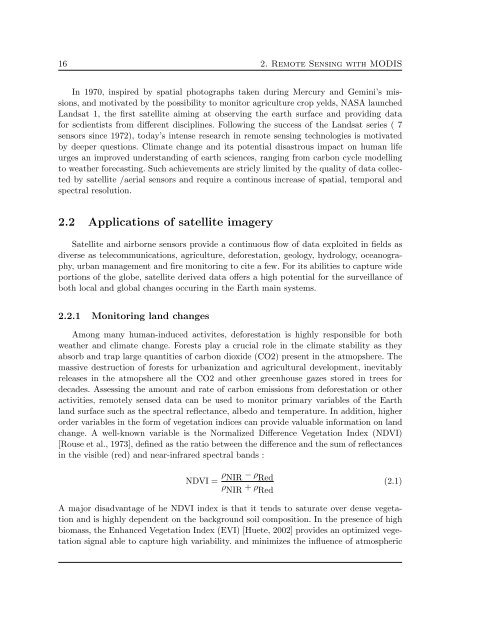Th`ese Marouan BOUALI - Sites personnels de TELECOM ParisTech
Th`ese Marouan BOUALI - Sites personnels de TELECOM ParisTech
Th`ese Marouan BOUALI - Sites personnels de TELECOM ParisTech
You also want an ePaper? Increase the reach of your titles
YUMPU automatically turns print PDFs into web optimized ePapers that Google loves.
16 2. Remote Sensing with MODIS<br />
In 1970, inspired by spatial photographs taken during Mercury and Gemini’s missions,<br />
and motivated by the possibility to monitor agriculture crop yelds, NASA launched<br />
Landsat 1, the first satellite aiming at observing the earth surface and providing data<br />
for scdientists from different disciplines. Following the success of the Landsat series ( 7<br />
sensors since 1972), today’s intense research in remote sensing technologies is motivated<br />
by <strong>de</strong>eper questions. Climate change and its potential disastrous impact on human life<br />
urges an improved un<strong>de</strong>rstanding of earth sciences, ranging from carbon cycle mo<strong>de</strong>lling<br />
to weather forecasting. Such achievements are stricly limited by the quality of data collected<br />
by satellite /aerial sensors and require a continous increase of spatial, temporal and<br />
spectral resolution.<br />
2.2 Applications of satellite imagery<br />
Satellite and airborne sensors provi<strong>de</strong> a continuous flow of data exploited in fields as<br />
diverse as telecommunications, agriculture, <strong>de</strong>forestation, geology, hydrology, oceanography,<br />
urban management and fire monitoring to cite a few. For its abilities to capture wi<strong>de</strong><br />
portions of the globe, satellite <strong>de</strong>rived data offers a high potential for the surveillance of<br />
both local and global changes occuring in the Earth main systems.<br />
2.2.1 Monitoring land changes<br />
Among many human-induced activites, <strong>de</strong>forestation is highly responsible for both<br />
weather and climate change. Forests play a crucial role in the climate stability as they<br />
absorb and trap large quantities of carbon dioxi<strong>de</strong> (CO2) present in the atmopshere. The<br />
massive <strong>de</strong>struction of forests for urbanization and agricultural <strong>de</strong>velopment, inevitably<br />
releases in the atmopshere all the CO2 and other greenhouse gazes stored in trees for<br />
<strong>de</strong>ca<strong>de</strong>s. Assessing the amount and rate of carbon emissions from <strong>de</strong>forestation or other<br />
activities, remotely sensed data can be used to monitor primary variables of the Earth<br />
land surface such as the spectral reflectance, albedo and temperature. In addition, higher<br />
or<strong>de</strong>r variables in the form of vegetation indices can provi<strong>de</strong> valuable information on land<br />
change. A well-known variable is the Normalized Difference Vegetation In<strong>de</strong>x (NDVI)<br />
[Rouse et al., 1973], <strong>de</strong>fined as the ratio between the difference and the sum of reflectances<br />
in the visible (red) and near-infrared spectral bands :<br />
NDVI = ρ NIR − ρ Red<br />
ρ NIR + ρ Red<br />
(2.1)<br />
A major disadvantage of he NDVI in<strong>de</strong>x is that it tends to saturate over <strong>de</strong>nse vegetation<br />
and is highly <strong>de</strong>pen<strong>de</strong>nt on the background soil composition. In the presence of high<br />
biomass, the Enhanced Vegetation In<strong>de</strong>x (EVI) [Huete, 2002] provi<strong>de</strong>s an optimized vegetation<br />
signal able to capture high variability. and minimizes the influence of atmospheric















